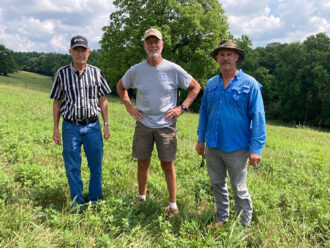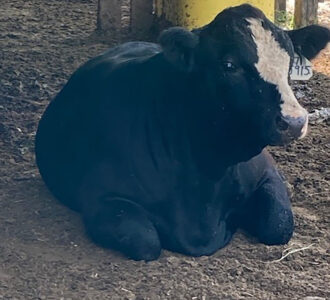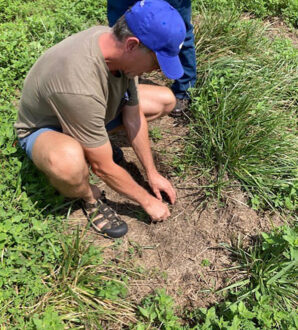LEXINGTON, Kentucky – Livestock farmers in Kentucky are changing the way they feed hay to cattle during the winter to prevent nutrient loss, regenerate pastures and keep animals healthy.
Generally, hay is fed to livestock on a feeding pad or sacrifice area, or is unrolled in a pasture. In the case of a feeding pad, most of the nutrients imported with the hay are lost to leaching. The potassium and nitrogen from cattle urine are lost, and those animals suffer cold stress from the mud pits that develop. Manure, if not spread, is collected in a pile and can cause environmental issues, especially on sloped land. Unrolling hay in pasture can cause compaction, either from tractors or from cattle trampling.
University of Kentucky researchers, through a Southern Sustainable Agriculture Research and Education (SSARE) On-Farm Research Grant, have found a better way to feed winter hay: a technique called bale grazing.
Bale grazing is a practice where bales are set out on pasture before winter and cattle are fed in a planned, controlled manner. University of Kentucky forage economist Extension professor, Greg Halich, equates bale grazing to rotational grazing. “Temporary electric fence and posts are used to give cattle access to the bales that you want fed in the current move. The fence is moved to expose new bales, usually 25-100 feet at a time,” said Halich. “Hay rings that protected the previous bales are rolled to the new bales and flipped over into place. The process is typically repeated every 1-7 days.”
Halich has been toying with bale grazing on his own farm for the past ten years, after he saw the practice being implemented in Canada and more northern U.S. states. He was convinced the practice could work in the South, with some modifications to account for warmer winter weather to avoid pasture damage from cattle.
“Properly planned, you will not need to use a tractor the entire winter and nutrients will be deposited where they are needed. Simple, cheap and effective. A well-executed bale grazing system will substantially reduce tractor use for feeding hay, in many cases by as much as 90 percent. Additionally, cattle generally stay much cleaner through the winter with very little mud on their hides. This is especially important with calves,” said Halich. “If we can alleviate the fear that many cattle farmers have of destroying their pastures through this type of hay feeding, we could promote more widespread adoption of bale grazing, and the associated benefits.”
Through the two-year grant, Halich worked with several small cattle farmers in evaluating bale grazing on their pastures -- collecting data on nutrient accumulation, forage response, soil compaction, and labor/equipment inputs.

The farmers, at first, were skeptical.
“I thought he was crazy,” Dorris Bruce said matter-of-factly. Bruce has been farming for 40 years and raising cattle for half that time, managing 14 head. “For 20 years my cattle were on a feeding pad. Now I no longer use it, except to wean calves. Bale grazing minimizes the waste you get from the feeding pad and eliminates that stationary feeding scenario.”
Bruce said he also recognized the fertilizer value the hay provided through bale grazing. He estimates that over the 2-year project period, he saved 1,431 pounds of nitrogen and 3,825 pounds of potassium. “All of those nutrients would have been lost on the feeding pad,” he said.
Results from the On-Farm Research Grant showed that bale grazing increased nutrients on pasture, with the biggest changes to nutrient concentrations closest to the where the bale was being fed.
Bruce noticed his pasture health was improving. “Broomsedge was disappearing,” he said. Broomsedge is a weed whose presence indicates low fertility.
Dave Burge’s experience with bale grazing was just as eye-opening. It was the increased soil health benefits that turned him on to the practice.
“It was an environmental transformation of my fields,” said Burge, who has raised cattle for over two decades. He currently manages 30 head.
Burge was using a sacrifice area for cattle feeding during the winter, which he said, was always a mess of tractor ruts, mud and compacted soil. “With bale grazing, my pastures were more fertile. They increased their water holding capacity. And my soil organic matter was increasing,” said Burge. “Year 2 of the project I was seeing dung beetles in my fields, getting those nutrients back into the soil.” Burge tested 1/3 of his 110 acres on the bale grazing technique.
Cattle farmer Mike Wilson also noticed changes to his pastures with bale grazing. “I had 10 acres of gamagrass and the last two years it didn’t do anything. I bale grazed on it and this year it’s back.”
Halich said that through bale grazing, nutrients are being collected and stored for later use when the pasture needs it. “The N,P,K and micronutrients are getting recycled and the pastures are being fed year-round,” he said. “In some cases we are seeing amazing forage growth in the spring. Bale grazing has the potential to close the nutrient cycle on cattle farms. Instead of nutrients constantly leaking out of the system, they are held in place. Efficient close nutrient cycles will need little to no commercial fertilizer.”

In order for bale grazing to work in the Southern region, said Halich, some changes need to be made to the technique. The biggest modification is reducing the density of hay bales per acre.
“In the northern regions of the U.S. where the ground freezes in winter, the hay bale density is high – 10 bales per acre or more. Farmers can do that there because there is little soil damage from cattle trampling,” said Halich. “In the South, farmers need to reduce their bale density to around 3-6 bales per acre. This reduces the amount of time cattle are on any one pasture.”
Halich said the farmers in the study also found bale grazing to be a more labor efficient system than feeding cattle on a concrete pad.
Burge remarked on how efficient the system is when it comes to saving on labor and use of machinery. “Conservatively, it would take me 3 hours a week to work the cattle on a feeding pad. With bale grazing, I was spending one hour every 5-7 days to move the fence and roll the ring onto a new hay bale. The tractor was only in the field one time before winter to place the bales,” said Burge. “It’s an extremely efficient system.”
Halich continues to work with farmers in Kentucky on implementing bale grazing across the state. University of Kentucky recently received a $2.6 million Natural Resources Conservation Service (NRCS) On-Farm Conservation Innovation Grant to expand the project across six states: Kentucky, West Virginia, Virginia, North Carolina, New York and Missouri.
“This grant will provide additional demonstration farms, as well as provide research on soil nutrient level changes, soil health changes, forage production changes, and profitability changes,” said Halich. “This grant would likely not have been possible without the SARE On-Farm Research Grant.”
